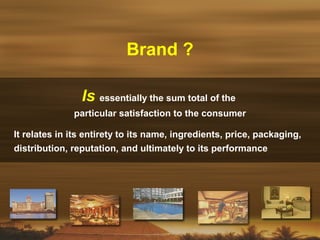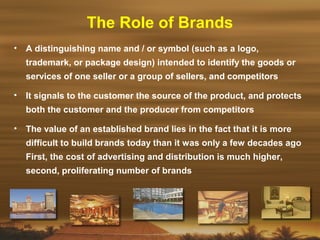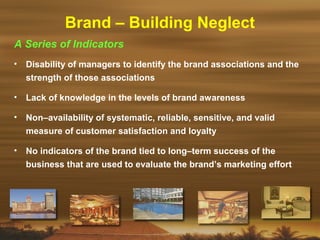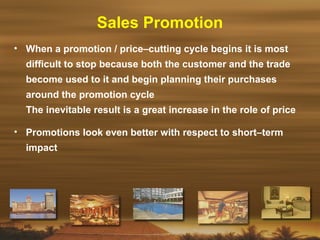Brand building sunil taneja
- 1. An identify for a product Like identifying a specific person within a large crowd... Brand ?
- 2. Is essentially the sum total of the particular satisfaction to the consumer It relates in its entirety to its name, ingredients, price, packaging, distribution, reputation, and ultimately to its performance Brand ?
- 3. We expect certain standards of quality from these brands When we want to buy a washing powder, we specially ask for Surf, Ariel or some such brand Brand ?
- 4. Brand Equity • Encompasses a set of assets linked to a brand’s name and symbol which add value to a product or service • There is always the underlying expectation for the promised satisfaction • A brand is the evaluation of its performance by the consumer making it responsible for the premium price as against the competition which is a major strength of brand equity
- 5. Firstly Reasoning for Fascination With Brands Brand Equity • They create Trust, and trust is the basic precondition to Loyalty • Result into loyalty which ensure sustainable income to the companies that own these brands • It is the relationship, born out of loyalty, that ensures continuous sales, and therefore profit to the company
- 6. • They can be shown to be valuable to shareholders • A strong Brand Equity enables the brand to command a premium • Customers are prepared to pay a premium because of the perceived reliability, trustworthiness, as well as the positive image of superior quality Brand Equity Reasoning for Fascination With Brands Secondly
- 7. Brand Equity • Brand Awareness – Strength of a brand’s presence in the consumer’s mind which is measured according to the recognition and recall of the brand Major Assets • Perceived Quality – Lies at the heart of what customers are buying; and is the ultimate measure of the impact of a brand
- 8. Major Assets • Brand Loyalty – Since a company considers loyalty as a major asset, it encourages and justifies loyalty building programmes which, in turn, helps create and enhance Brand Equity Brand Equity
- 9. MARKETING Brands Add Value The Value Focus Approach Provide The Value • Product development • Manufacture • Service • Price Communicate The Value • Sales message • Advertising / Promotion Choose The Value • Understand value desires • Select target • Define benefits / price TRIKAYA-GREY
- 10. Brand Equity The First Part – An Idea The Building of a Brand Like an Architect, the Marketing Manager must be able to visualise whether there is a consumer need for a particular product and only when he is able to pinpoint this particular need, he can proceed further in terms of satisfying that need
- 11. Brand Equity The Building of a Brand The Second Part – Inputs Like construction of a building, he must have certain ingredients to build up the brand which will satisfy the need eg. the physical properties, positioning, looks, price and so on
- 12. The Third Part – A Process The process include research, the logic behind the introduction of the brand, creativity in terms of projecting the brand to the consumer and ensuring adequate quality control to deliver the promised performance Brand Equity The Building of a Brand
- 13. Brand Equity This process is a continuous one A brand is built brick–by–brick, not only does it take time, but importantly – it takes money and patience. Unfortunately, most of our aspiring industrialists are only traders ; they want to see profit almost immediately. Very rarely does a brand become profitable before the first three introductory years are over. e.g. Nirma, Titan, etc. The Building of a Brand
- 14. The Role of Brands • A distinguishing name and / or symbol (such as a logo, trademark, or package design) intended to identify the goods or services of one seller or a group of sellers, and competitors • It signals to the customer the source of the product, and protects both the customer and the producer from competitors • The value of an established brand lies in the fact that it is more difficult to build brands today than it was only a few decades ago First, the cost of advertising and distribution is much higher, second, proliferating number of brands
- 15. A Series of Indicators Brand – Building Neglect • Disability of managers to identify the brand associations and the strength of those associations • Lack of knowledge in the levels of brand awareness • Non–availability of systematic, reliable, sensitive, and valid measure of customer satisfaction and loyalty • No indicators of the brand tied to long–term success of the business that are used to evaluate the brand’s marketing effort
- 16. Brand – Building Neglect • Absence of people in the firm who are really charged with protecting the brand equity • Short term performance measures for the personnel associated with the brand • No mechanism to measure and evaluate the impact of elements of the marketing program upon the brand • No long – term strategy for the brand A Series of Indicators
- 17. Sales Promotion • Sales Promotions are effective – they affect sales in an immediate and measurable way During a week in which a promotion is run, dramatic sales increases are observed for many product classes : 443% for fruit drinks, 194% for frozen dinners, and 122% for laundry detergents • Promotions provide a way to keep a third - or - fourth - ranking brand on the shelf
- 18. Sales Promotion • When a promotion / price–cutting cycle begins it is most difficult to stop because both the customer and the trade become used to it and begin planning their purchases around the promotion cycle The inevitable result is a great increase in the role of price • Promotions look even better with respect to short–term impact
- 19. • The enhanced role of promotions is in part driven by measurement. With the advent of the scanner–based databases in food and drug stores, the short–term measures of some marketing actions are better than ever. They show that price promotions affect sales • There are no easy, defensible ways to measure the long–term effects of marketing actions, and hence short–term measures have added influence eg. The situation is a bit like that of the drunk who looks for car keys under a street light because the light is better than where the keys were actually lost. Sales Promotion
- 20. What is Brand Equity ? …something that is made in a factory …can be copied by a competitor …can be quickly outdated ...something that is bought by a customer ...is unique ...successful brand is timeless A Product A Brand
- 21. The Ivory Story • In December, 1881, P&G ran their first Ivory ad, stating that the soap “floated” and that it was “99 44 / 100% pure ,” • It has become one of the most famous ad slogans ever • The “aggressive” 1882 national advertising budget of $11,000 provided a start toward high brand awareness, and customer confidence • The key to the success of P&G is its commitment to the development of brand equity





















